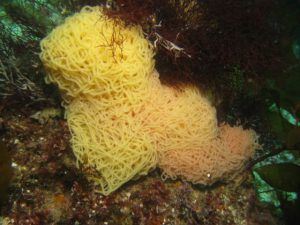
The sea hare is one of the most amazing invertebrates you can see in the waters surrounding Catalina Island and here at CIMI. You can find two different species in our coves and our aquariums – the California sea hare and the black sea hare. Sea hares belong to the phylum mollusca, making them relatives of other gastropods like slugs and snails, as well as squids, octopuses, and clams. These marvelous molluscs were named sea hares (Latin: lepus marinus) by the ancient Romans because of their rhinophores, two appendages on the top of the animal’s head that look a lot like rabbit ears. Sea hares also display large wing-like flaps on their backs known as parapoidea, which can sometimes be used for swimming. The California sea hare can grow to be as large as sixteen inches long and five pounds, while the black sea hare is the largest gastropod, sometimes reaching over two feet long and more than thirty pounds!


 The sea hare begins its life as one of as many as eighty million eggs, all laid in a large mass that looks a little bit like a bunch of spaghetti. Only twelve days after being laid, the sea hare larvae are ready to hatch. For the first thirty days of its life, a larval sea hare is planktonic. This means that the animal is largely unable to control its movements and floats about on ocean waves and currents. After about thirty days, the sea hare has grown large enough to no longer be planktonic. Over the next three months, the sea hare will double its body weight every ten days! Scientists who study sea hares have found that small juvenile individuals seem to prefer deeper water (up to 60 feet), while adults seem to prefer shallower water. But no matter how deep they live, sea hares will always prefer rocky areas with lots of algae for them to munch on. They especially love red algae, which gives them their dark red to brown (and black) coloring. In the California sea hare, the red algae also make the animals’ ink a purpleish-red color. The California sea hare uses this irritating ink as a defense mechanism against predators. Around Catalina, you can find sea hares enjoying a red algae snack of plocamium or pterocladia.
The sea hare begins its life as one of as many as eighty million eggs, all laid in a large mass that looks a little bit like a bunch of spaghetti. Only twelve days after being laid, the sea hare larvae are ready to hatch. For the first thirty days of its life, a larval sea hare is planktonic. This means that the animal is largely unable to control its movements and floats about on ocean waves and currents. After about thirty days, the sea hare has grown large enough to no longer be planktonic. Over the next three months, the sea hare will double its body weight every ten days! Scientists who study sea hares have found that small juvenile individuals seem to prefer deeper water (up to 60 feet), while adults seem to prefer shallower water. But no matter how deep they live, sea hares will always prefer rocky areas with lots of algae for them to munch on. They especially love red algae, which gives them their dark red to brown (and black) coloring. In the California sea hare, the red algae also make the animals’ ink a purpleish-red color. The California sea hare uses this irritating ink as a defense mechanism against predators. Around Catalina, you can find sea hares enjoying a red algae snack of plocamium or pterocladia.

A California sea hare’s bright red ink – thanks to algae!
After about four months, sea hares reach maturity and are capable of laying eggs of their own. All species are hermaphroditic. This means that each individual is capable of acting as both a male and a female during reproduction. As many as twenty individuals can gather at the same time in order to reproduce in what scientists call mating chains.
The typical lifespan for a sea hare is only about one year, however, cooler water like that surrounding Catalina Island helps to extend the lifespan by delaying the spawning (mating) process.


